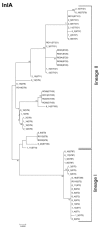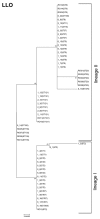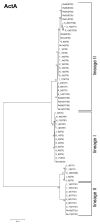Listeria monocytogenes Isolated from Illegally Imported Food Products into the European Union Harbor Different Virulence Factor Variants
- PMID: 30142903
- PMCID: PMC6162745
- DOI: 10.3390/genes9090428
Listeria monocytogenes Isolated from Illegally Imported Food Products into the European Union Harbor Different Virulence Factor Variants
Abstract
Unregulated international flow of foods poses a danger to human health, as it may be contaminated with pathogens. Recent studies have investigated neglected routes of pathogen transmission and reported the occurrence of Listeria monocytogenes in food illegally imported into the European Union (EU), either confiscated at four international airports or sold illegally on the Romanian black market. In this study we investigated the genotype diversity and the amino acid sequence variability of three main virulence factors of 57 L. monocytogenes isolates. These isolates were derived from 1474 food samples illegally imported into the EU and originated from 17 different countries. Multilocus sequence typing revealed 16 different sequence types (STs) indicating moderate genotype diversity. The most prevalent STs were ST2, ST9, and ST121. The pulsed-field gel electrophoresis (PFGE) analysis resulted in 34 unique pulsotypes. PFGE types assigned to the most prevalent STs (ST2, ST9, and ST121) were highly related in their genetic fingerprint. Internalin A (InlA) was present in 20 variants, including six truncated InlA variants, all harbored by isolates of ST9 and ST121. We detected eight ST-specific listeriolysin O (LLO) variants, and among them, one truncated form. The actin-assembly-inducing protein ActA was present in 15 different ST-specific variants, including four ActA variants with an internal truncation. In conclusion, this study shows that L. monocytogenes, isolated from illegally imported food, have moderate genotype diversity, but diverse virulence factors variants, mainly of InlA.
Keywords: ActA; European Union; Listeria monocytogenes; food; genotyping; illegal; internalin A; listeriolysin O; neglected routes; virulence factors.
Conflict of interest statement
The authors declare no conflict of interests. The founding sponsors had no role in the design of the study; in the collection, analyses, or interpretation of data; in the writing of the manuscript, and in the decision to publish the results.
Figures







References
-
- Beutlich J., Hammerl J.A., Appel B., Nockler K., Helmuth R., Jost K., Ludwig M.L., Hanke C., Bechtold D., Mayer-Scholl A. Characterization of illegal food items and identification of foodborne pathogens brought into the European Union via two major German airports. Int. J. Food Microbiol. 2015;209:13–19. doi: 10.1016/j.ijfoodmicro.2014.10.017. - DOI - PubMed
LinkOut - more resources
Full Text Sources
Other Literature Sources

